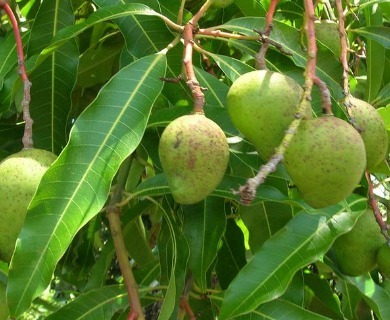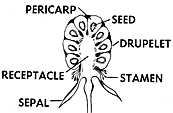Mango
Mangifera indica
Sumac family (Anacardiaceae)
Post-Cook introduction
Mango is well known for its large elliptical or egg-shaped yellow or pinkish with edible flesh and large seed in a mass of fibers. The tree is also a handsome ornamental and shade tree with a very dense rounded of large narrow dark green leaves, drooping in showy red-brown clusters when first produced, and with large clusters of small yellow green to pink flowers. Also, the wood has many uses.

©2006 Forest And Kim Starr
Leaves hairless, with leaf-stalks 1⁄2–1 1⁄2 inches (1.3–4 ) long, swollen at base. Blades lance-shaped or narrowly oblong, 6–12 inches (15–30 ) long and 1 1⁄2–3 inches (4–7.5 ) wide, long-pointed at both ends or short-pointed at base, curved upward from with many straight side veins and sometimes with edges a little wavy, leathery, shiny dark green above, paler beneath.
Flower clusters () are large, showy, 6–8 inches (15–20 ) or more in length, with reddish hairy branches. Flowers numerous, five-parted, about 1⁄4 inch (6 ) wide, short-stalked finely hairy fragrant, partly male and partly (polygamous). yellow green, 1⁄16 inch (1.5 ) long, deeply five- of five spreading petals more than 1⁄8 inch (3 ) long, pink, turning reddish; five one fertile and four shorter and sterile, borne on a and in some flowers a with single-celled and slender lateral
() hanging on long stalks, large, aromatic, mostly 3–4 1⁄2 inches (7.5–11 ) long, larger in improved varieties, slightly narrowed toward blunt and a little flattened, with smooth thin skin, soft at maturity, with thick juicy yellow or orange flesh. Seed case 2 1⁄2–3 1⁄2 inches (6–9 ), flattened, with long ridges and grooves, containing 1 seed. Flowering mainly in winter and spring and maturing about 6 months later from spring to fall. If rains are prolonged during the flowering period, a fungus (Colletotrichum gloeosporioides) destroys the flowers, and a poor crop results.
The wood is lustrous blond without distinct sapwood. It is however, frequently stained during drying and may be mottled with darker spots. The heartwood when it forms in very old trees is dark brown. Wood is hard, moderately heavy ( gr. 0.57), tough, strong, and medium-textured and has straight to wavy grain, often with a pronounced curly or fiddleback figure. It shrinks very little in drying, so seasons well and stays in place despite humidity changes. Machining characteristics of Puerto Rican wood are as follows: planing, shaping, and turning are fair; boring, mortising, and resistance to screw splitting are good; and sanding is poor. The wood works easily, but grain irregularities cause tear-outs. It is susceptible to attack by dry-wood termites and is not resistant to decay.
In Hawaii the wood has been employed for furniture, paneling, carved and turned bowls and trays, and gunstocks. Elsewhere, it has been used for flooring, construction, boxes and crates, carts, plywood, dry cooperage, and meat chopping-blocks. In French Oceania and the Cook Islands, most canoes are made from mango. Beautiful furniture has been made from a variety grown near Hilo that invariably has pronounced curly grain. The First Methodist Church in Hilo has a spectacular display of mango paneling on the wall behind the altar.
Mango is one of the most popular through the tropics. Though usually eaten raw, mangos are also cooked or made into preserves, jelly, juice, or chutney. Numerous improved varieties with larger and less fibrous have been developed. Many of these have several embryos (polyembryonic) and breed true from seed. Others with a single (monoembryonic) must be propagated vegetatively by budding or grafting. The most popular mango cultivars in Hawaii are ‘Hayden’, ‘Pirie’, and ‘Shibata’. ‘Pirie’ was introduced in 1899 and ‘Hayden’ in 1930. Green mango is quite popular and is often pickled.
Mango is an excellent hardy shade tree. It is also among the important honey plants, secreting quantities of and the flowers reportedly are edible. Livestock eat the The seeds, flowers, bark, leaves, and resin have been employed medicinally, and the bark and leaves yield a yellow dye.
Some people have skin sensitive to the resinous sap of the peel and foliage, developing a rash similar to the rash from poison-ivy, which is in the same plant family. Climbing trees to gather is hazardous because of the brittle branches.
Mango has been cultivated for more than 4000 years in India, where more than 500 cultivars are known. It was introduced into Hawaii probably prior to 1825 by Don Francisco Paula y Marin (1774–1837). Don Marin, Spanish-born friend and advisor of the Hawaiian king, imported such as the pineapple and other plants from many parts of the world. The first introductions were from three different countries—Chile, the Philippines, and China—and more than 40 improved selections followed later. The Mediterranean fly and mango flies, which damage the developing came too!
In Hawaii, mango is planted and naturalized mainly in the lowlands through the islands. Huge old common mango trees are found occupying overgrown home sites in all the wetter valleys. There are estimated to be about 4 million board feet of mango sawtimber in Hawaii.
Special areas
Keahua, Waimea Arboretum, Foster, Tantalus
Champion
Height 71 ft (21.6 ), c.b.h. 24.7 ft (7.5 ), spread 70 ft (21.3 ). Rainbow Falls State Park, Hilo, Hawaii (1968).
Range
Native to tropical India, probably from India east to Vietnam. Widely planted as a tree and naturalized in tropical regions. Cultivated in southern Florida, where it is naturalized locally, and in southern California. Common in Puerto Rico and Virgin Islands.
Other common names
iedel (Palau); manga (Yap); kangit (Truk and Pohnpei)








